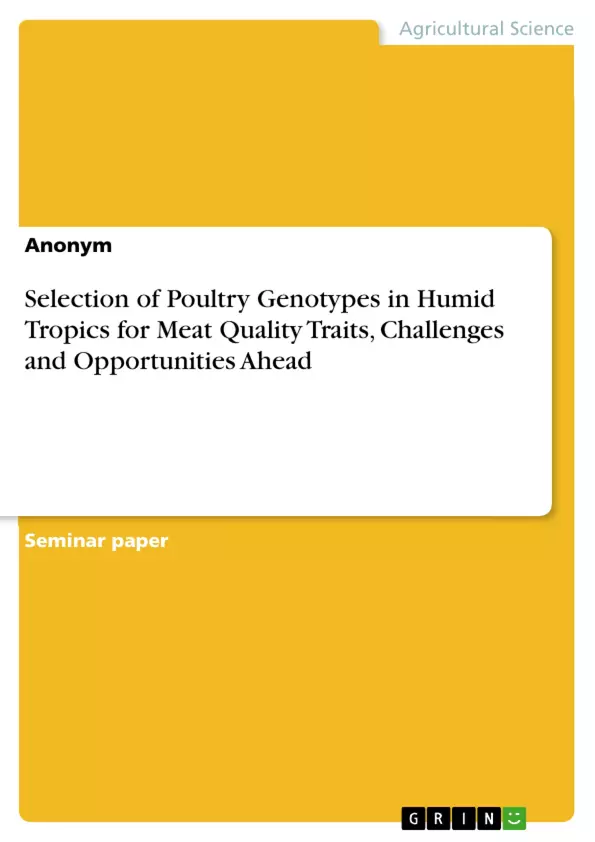The objective of this paper is to review selection of poultry genotypes in humid tropics for meat quality traits, the challenges, and opportunities including selection of poultry genotypes, breeds of broilers kept by the farmers, selection criteria, and trait preference for meat quality in humid tropics.
The indigenous village chicken is the most prominent class of livestock in the country and constitutes about 60-80% of the total poultry population, their productivity levels are low because of low genetic potential and poor nutrition. To overcome the problem of low productivity in local chickens, high-yielding exotic breeds have been introduced through cockerel exchange program by the government. This intervention is bedeviled with many challenges; prominent among them is the birds’ inability to adapt to the humid and hot environment, resulting in reduced feed intake and retarded growth.
A number of major heat-tolerant genes or gene complexes like naked-neck, ptylopody, polydactyly and frizzle have been identified in the genome of Ghanaian local chicken populations. These unique genes have been reported to ameliorate tropical heat stress and enhance the performance of chickens under hot and humid environments. The existence of the naked-neck gene results in 20-30% less feather coverage overall, with the lower neck of the bird appearing almost naked while the frizzle gene but is reported to reduce the insulating properties of the feather cover (reduce featherweight) and make it easier for the bird to radiate heat from the body.
Inhaltsverzeichnis (Table of Contents)
- INTRODUCTION
- Literature review
- National poultry genotype sector policies
- Genetic selection
- Genomic prediction
- Main selection criteria
- Carcass traits
- Carcass components of poultry meat
- Meat Type Chickens
- Major genes affecting heat tolerance
- Meat traits
- Effect of High Temperature on Meat Quality
- Effect of High Temperature on heat production
- Opportunity of Genetic Selection on the Welfare of Chickens
- Challenges of Genetic Selection on the welfare of chickens
- Genetic selection methods
- Selection Strategies
- Summary
- Recommendation
- References
Zielsetzung und Themenschwerpunkte (Objectives and Key Themes)
This paper aims to provide a comprehensive overview of the selection of poultry genotypes in humid tropics for meat quality traits, outlining the challenges and opportunities associated with this process. It explores various aspects, including the selection criteria, breed preferences, and impact of high temperatures on meat quality and welfare.
- Selection of poultry genotypes for meat quality traits in humid tropics
- Challenges associated with genetic selection in humid environments
- Opportunities for improving poultry production through genetic selection
- Impact of high temperatures on poultry welfare and meat quality
- The role of heat-tolerant genes in improving poultry performance
Zusammenfassung der Kapitel (Chapter Summaries)
The introduction discusses the importance of improving poultry productivity in tropical regions, highlighting the challenges faced by exotic breeds in adapting to humid and hot environments. It explores the potential of unique genes like naked-neck and frizzle in enhancing heat tolerance. The chapter then examines the detrimental effects of heat stress on poultry performance and welfare, emphasizing the need for developing heat-tolerant poultry stocks.
The literature review delves into national poultry genotype sector policies, emphasizing the growing concerns regarding food safety, product quality, environmental pollution, and animal welfare. The chapter further explores the concept of genetic selection, particularly focusing on the breeding of humid tropic tolerant broilers. It examines the challenges in implementing evaporative cooling systems in tropical regions and highlights the importance of crossbreeding between indigenous and exotic breeds for better adaptation.
Schlüsselwörter (Keywords)
This paper centers around key terms and concepts related to poultry production in humid tropics, including heat tolerance, genetic selection, meat quality traits, crossbreeding, and welfare. It explores the challenges and opportunities associated with developing breeds resistant to high temperatures and explores the impact of heat stress on poultry performance and meat quality. Key themes include the selection of poultry genotypes, the role of heat-tolerant genes, and the impact of climate on poultry welfare and production.
- Quote paper
- Anonym (Author), 2018, Selection of Poultry Genotypes in Humid Tropics for Meat Quality Traits, Challenges and Opportunities Ahead, Munich, GRIN Verlag, https://www.grin.com/document/1005551



